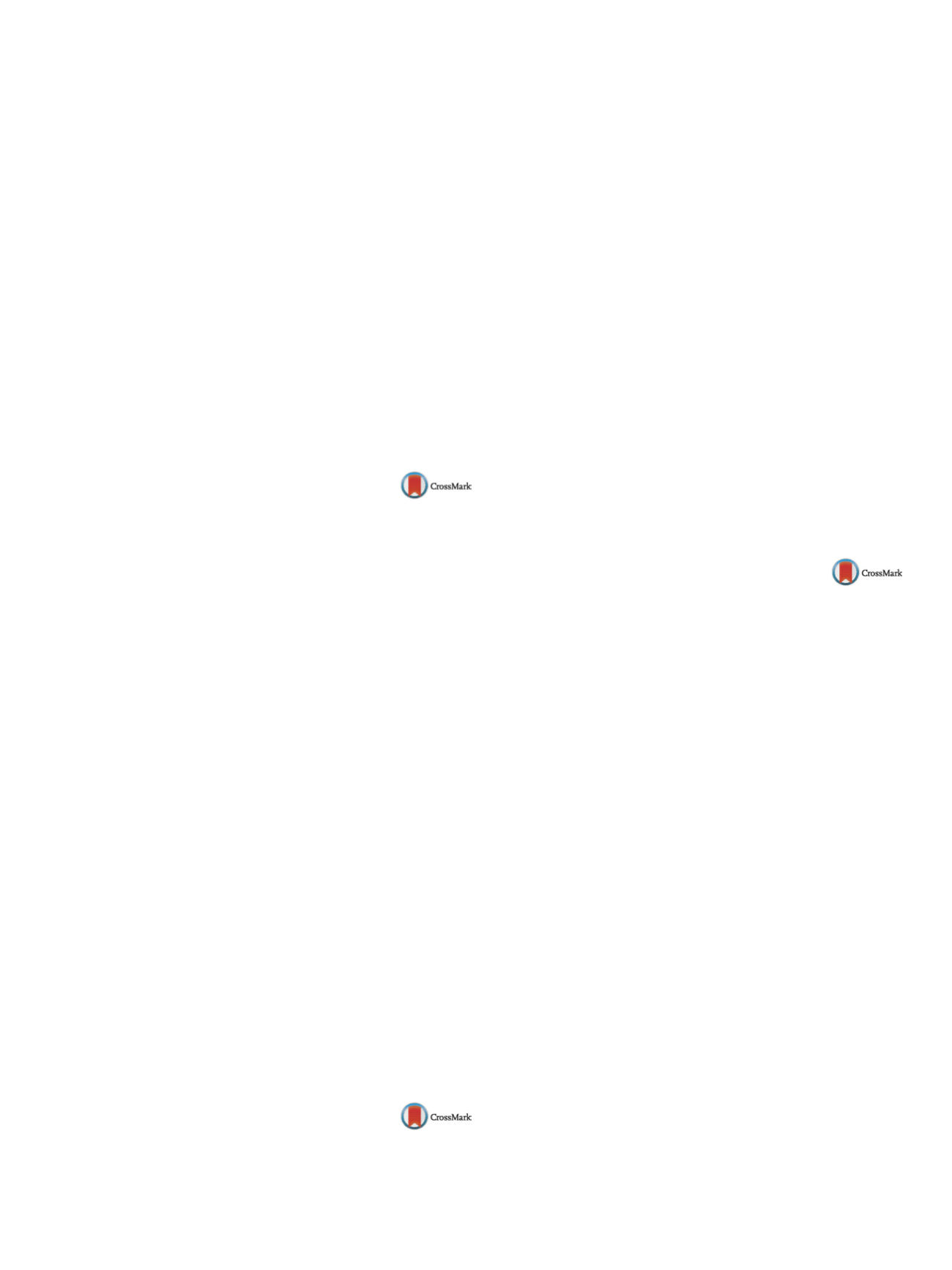

25th European Congress of Psychiatry / European Psychiatry 41S (2017) S772–S846
S843
Results
The frequency of psychotraumas, social stress and physi-
cal abuse in our group was significantly higher in women (63.33%),
in patients with urban residence (80.00%) and age group 36–45
years (46.67). There was a pattern of residual defectuality reflected
by positive symptoms (83.33%), alcohol abuse (80.00%), aggres-
sive behavior (66.67%) and suicide attempts (30.00%). The poor
course with minimal social functioning (GAFS < 40; 36.67%) was
correlated with a high number of relapses and hospitalizations (> 9
hospitalizations; 43.33%), cognitive deficit (MMSE < 23; 76.67%).
The psychosocial factors involved in the pathogenesis and course of
schizophrenia were social stress (60.00%), physical abuse in child-
hood and adolescence (20.00%) and psychotraumas (20.00%).
Conclusions.
Psychotrauma and physical abuse in childhood and
adolescence and during the course of paranoid schizophrenia con-
stitute a risk factor for a poor outcome with cognitive deterioration,
aggressive and suicidal behavior that call for prophylactic meas-
ures and qualified psycho-social interventions associated to the
pharmacological treatments.
Disclosure of interest
The authors have not supplied their decla-
ration of competing interest.
http://dx.doi.org/10.1016/j.eurpsy.2017.01.1664EV1335
Differential diagnosis and therapy of
cycloid psychoses: A case report
A.M. Uminska-Albert
∗
, G. Eikmeier
Klinikum Bremerhaven, Klinik für Psychiatrie- Psychotherapie und
Psychosomatik, Bremerhaven, Germany
∗
Corresponding author.
Kraepelin already challenged his dichotomy of psychoses, because
in clinical practice too many cases were not in line with his pattern.
Different terms for these disorders were coined. Leonhard sepa-
rated cycloid psychoses fromother forms of endogenous psychoses.
The idealized subtypes (anxiety-beatific, hyperkinetic-akinetic-
motility and confusional exited-inhibited) are characterized by a
bipolar course with complete recovery. Operationalised criteria
were developed by Perris. We report on a 60 year old woman
diagnosed as schizophrenic in 1984/1985 and 2006. In August
2015 she was admitted with stupor and mutism and therefore
was treated with fluphenazine and lorazepame. Six days later the
clinical picture changed, she became confused and very agitated.
After change of treatment to benperidole her clinical condition
improved within 12 days. After 3 further days she became con-
fused, agitated and euphoric again. The symptoms persisted in spite
of a change of treatment to haloperidole. After diagnostic revi-
sion therapy was augmented with lithiumcarbonate. Six days later
the psychotic symptoms began to improve and were completely
remitted after 10 further days. The case report points out that a
differential-diagnostic revision of an apparently therapy-resistant
schizophrenia should not only be carried out according to ICD 10
criteria but a cycloid psychosis should be taken into account, too.
Perris-criteria are contrastedwith ICD 10-criteria for schizophrenia
andmania with psychotic symptoms. Symptomatology and clinical
course in our patient fulfilled exactly the Perris-criteria. We recom-
mend an augmentation trial with lithium in acute phases of cycloid
psychoses by all means before ECT.
Disclosure of interest
The authors have not supplied their decla-
ration of competing interest.
http://dx.doi.org/10.1016/j.eurpsy.2017.01.1665EV1336
Attitude of person living with
psychosis towards MH professionals:
A qualitative study
K. Vaiphei
1 ,∗
, P. Sreedaran
2, V. Sathyanarayanan
21
St. John’s Medical College Hospital, Psychiatry, Bangalore, India
2
St. Johns Medical College Hospital, Psychiatry, Bengaluru, India
∗
Corresponding author.
Aims
Studies investigating attitudes of people with mental ill-
ness are scarce. The aim of the present study was to investigate
person living with psychosis on their attitudes and perception
towards the mental health professionals in contact with mental
health services.
Methods
An in-depth interview was used to explore their lived
experiences and attitude towards mental health professionals.
Results
Both negative and positive attitudes were prevalent
among the patients. Most negative attitudes concerned on not giv-
ing time, the MHPs are most interested in financial gains. They
felt attitude changes according to diagnosis, psychosis perceived
as diagnosis with violence; they are more interested in protecting
themselves, perception that treating symptoms and not cause of
illness. On the contrary, they felt positive on the relationship and
time given to them.
Discussion and conclusions The PLWI’s attitude to MHPs could be a
product of the type of admission (forced upon), symptoms related
or on the type of service settings. The present study is purely qual-
itative, single settings, could not be generalised. However it points
on the need for sensitization of MHPs and relationship building
oriented intervention.
Disclosure of interest
The authors have not supplied their decla-
ration of competing interest.
http://dx.doi.org/10.1016/j.eurpsy.2017.01.1666EV1337
Parkinson’s disease and psychosis:
Report of a case
M. Valverde Barea
1 ,∗
, A. Espa˜na Osuna
1, F. Cartas Moreno
21
Complejo Hospitalario de Jaén, Psiquiatria, Jaen, Spain
2
USMC-Úbeda, Psiquiatria, Jaen, Spain
∗
Corresponding author.
Introduction
Jealous delusional ideation appears in 7-14% of
cases of Parkinson’s disease. Treatment with dopaminomimet-
ics drugs is a significant risk factor for psychosis. However, the
most likely etiology of psychosis in these patients is a loss of
central cholinergic function associated with age since described
psychosis even before the introduction of the L-Dopamine. Cogni-
tive impairment and sleep disorders are predictors of development
of psychosis.
Objective
Present a clinical case of psychosis in Parkinson’s dis-
ease and its treatment.
Method
Reason for consultation. Patient diagnosed with Parkin-
son’s disease with behavioral disorder and delusional.
Current illness
The patient after antiparkinsonian medication
has increased suspicion, self-referentiality, delusional jealousy
ideation to her husband, delusional interpretations regarding
somatic symptoms, insomnia and behavioral disorders with
aggression.
Family background
Mother with Alzheimer’s.
Personal history
No contact with mental health.
Psychopathological examination
Conscious, repetitive language,
dysphoric mood with delusions of prejudice and jealousy.
Mixed insomnia.
Diagnosis
Psychosis in Parkinson’s disease.
Treatment
Quetiapine 300mg/day. Carbidopa 25mg/L-dopa
100mg: 1-0-1. On subsequent visits quetiapine was suspended and
replaced by clozapine 200mg/day.
Results
The treatment of psychosis was effective with the use of
quetiapine and subsequently clozapine with good tolerance and
effectiveness. He also said lower antiparkinsonian medication.
Conclusions
Psychotic symptoms are the most common psychi-
atric clinic in Parkinson’s disease. Often not enough antiparkinso-
nian dopaminomimetics reduced to control psychotic symptoms
and use of antipsychotics is required. The use of antipsychotics in


















